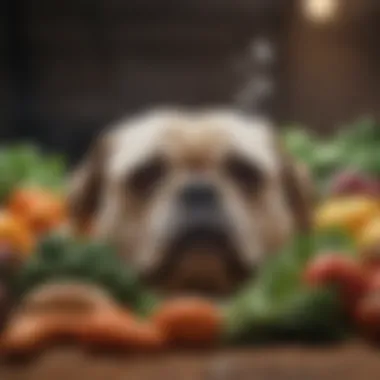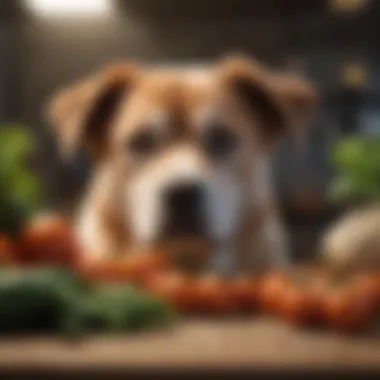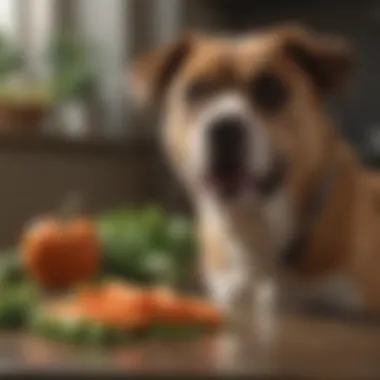Understanding Poisonous Vegetables That Can Harm Dogs


Intro
Pet owners often worry about the safety of their furry companions. One significant concern is the ingestion of vegetables that can be toxic to dogs. Understanding which vegetables are harmful is crucial to ensuring the well-being of pets. This article seeks to illuminate the varieties of vegetables that pose risks to dogs, highlighting the potential health impacts. Furthermore, it will discuss symptoms of poisoning, methods of prevention, and appropriate responses in case of exposure. By equipping dog owners with this vital information, we aim to promote responsible pet ownership and awareness regarding harmful foods.
Poisonous Vegetables Commonly Found in Households
Many households contain common vegetables that, while healthy for humans, can be dangerous for dogs. Some of the most notable ones include:
- Onions: These can damage red blood cells, leading to anemia.
- Garlic: Similar to onions, garlic can also cause oxidative damage to red blood cells.
- Tomatoes: The green parts of tomatoes are particularly toxic; ingestion can result in gastrointestinal upset.
- Potatoes: Uncooked potatoes and their green parts contain solanine, which can cause severe digestive issues.
Always be cautious about what's in your kitchen and how it affects your pets.
Symptoms of Poisoning
Ingestion of poisonous vegetables can manifest in various symptoms. Some common signs include:
- Vomiting
- Diarrhea
- Lethargy
- Weakness
- Abdominal pain
Signs can vary depending on the type of vegetable ingested and the quantity consumed. Prompt recognition of symptoms is key to preventing severe outcomes.
Prevention Strategies
To prevent poisoning incidents, pet owners should consider taking the following actions:
- Educate Family Members: Ensure everyone in the household understands which vegetables are harmful to dogs.
- Secure Storage: Keep toxic vegetables out of reach of dogs. Use containers that are difficult for pets to access.
- DiscourageTable Scraps: Avoid feeding dogs scraps from dinner plates, as these may contain harmful ingredients.
Immediate Response to Poisoning
In cases where a dog is suspected to have ingested a poisonous vegetable, immediate action is essential. Here are steps to follow:
- Call a Veterinarian: Always seek professional help when in doubt.
- Bring Evidence: If possible, gather any remaining parts of the vegetable or packaging to provide information to the vet.
- Monitor Symptoms: Keep track of any symptoms that manifest after ingestion, as they will be useful for the veterinarian.
Understanding the specifics of poisonous vegetables for dogs is essential for every pet owner. By reviewing this information and adopting preventive measures, one can significantly reduce the risk of harmful interactions between dogs and household foods. This knowledge is a pivotal aspect of responsible pet ownership and contributes to the overall health and safety of beloved pets.
Foreword to Dog Nutrition
Understanding dog nutrition is a vital aspect of responsible pet ownership. Just like humans, dogs require a balanced diet to maintain health and vitality. Proper nutrition can impact their energy levels, coat quality, and overall well-being. Furthermore, nutritional needs can change based on age, activity level, and health conditions.
When considering the diet of a dog, one must recognize the significance of whole foods. Whole foods, including vegetables, can offer essential vitamins and minerals. Notall vegetables are safe, however. Some can be highly toxic and lead to serious health issues if consumed by dogs. Therefore, this article focuses on the dangers of certain vegetables.
Key Elements of Dog Nutrition:
- Balanced Diet: Dogs need a mix of proteins, carbohydrates, fats, vitamins, and minerals.
- Age Considerations: Puppies, adults, and senior dogs have different dietary requirements.
- Health Conditions: Dogs with specific health issues may need specialized diets.
Certain vegetables, while nutritious for humans, can be harmful or even deadly to dogs. It is essential to identify these vegetables to prevent unintended poisoning. In addition to understanding which vegetables are safe, recognizing the symptoms of vegetable poisoning is crucial.


By gaining a solid understanding of dog nutrition, pet owners can make informed choices for their pets. This knowledge allows for the prevention of potential health threats stemming from improper diets. Knowing what to include and what to avoid enhances the loving bond between the pet and owner, ensuring a long and healthy companionship.
"Nutrition is the cornerstone of health; understanding it leads to better pet care decisions."
Identifying Poisonous Vegetables
Identifying poisonous vegetables is crucial for dog owners. Many common foods that humans consume can be toxic to dogs. Understanding which vegetables fall into this category allows for informed decision-making when feeding pets. Dogs are naturally curious animals, often sniffing around or scavenging for food. Therefore, recognizing the signs of vegetable toxicity is essential to protect their health.
Several factors influence whether a vegetable is toxic to dogs, including the type of vegetable, its preparation, and the amount ingested. Knowledge in this area can prevent potential health issues.
Benefits of Identifying Poisonous Vegetables:
- Health Protection: Avoiding toxic vegetables safeguards dogs from health complications.
- Awareness: Understanding toxicity helps owners become more vigilant in their dog's diet.
- Education: Learning about vegetable toxicity can inform other pet owners and friends, promoting safe practices.
Common Signs of Vegetable Poisoning in Dogs
When a dog consumes a poisonous vegetable, quick recognition of symptoms is essential for timely intervention. Symptoms may range from mild to severe and can present in various ways. Common signs of vegetable poisoning include:
- Vomiting: This is often the most noticeable organic reaction. A dog may vomit shortly after consuming the toxic vegetable.
- Diarrhea: Loose stools may signal gastrointestinal distress, which can follow ingestion.
- Lethargy: A decrease in energy levels or unusual quietness can indicate discomfort or illness.
- Loss of Appetite: If a dog suddenly refuses food, this change in behavior could be a red flag.
- Difficulty Breathing: If a dog shows signs of respiratory distress, seek veterinarian assistance immediately.
Recognizing these signs early can make a significant difference in the effectiveness of treatment. Always err on the side of caution with potential poisoning cases.
Understanding Vegetable Toxicity
Understanding vegetable toxicity involves examining several aspects, including the biochemical properties of vegetables, preparation methods, and the dog's specific health status.
Key Points to Consider:
- Biochemical Composition: Some vegetables contain compounds, like thiosulfates in onions, which are particularly dangerous for dogs.
- Preparation and Cooking: Cooking methods may change a vegetable's toxicity level. For example, raw potatoes have more solanine compared to cooked ones.
- Individual Sensitivity: Dogs, like humans, may have different reactions based on their health, age, and breed. One dog might tolerate a small amount of a toxic vegetable while another could have a severe reaction.
Understanding these elements creates a knowledgeable foundation for pet owners. They can make educated decisions regarding their dog's diet, reducing the risks associated with vegetable poisoning.
List of Poisonous Vegetables for Dogs
Understanding the dangers of certain vegetables is vital for dog owners. Many common vegetables can be toxic and even fatal if ingested by dogs. Identifying these vegetables can help in preventing unnecessary health risks. Knowledge about which vegetables are harmful allows pet owners to make informed choices about their dog's diet.
Onions
Onions contain compounds called thiosulfates, which are particularly harmful to dogs. When a dog consumes onions, thiosulfates can damage red blood cells. Symptoms of onion toxicity may not be immediate; they can take several days to manifest. Signs include weakness, vomiting, and breathlessness. It’s crucial to avoid giving dogs any onion, whether raw, cooked, or dehydrated, as the toxic effects remain despite cooking.
Garlic
Garlic is another vegetable in the allium family that poses risks to dogs. It is more toxic than onions on a per-gram basis, but dogs often need to eat a significant amount for the effects to be noticed. Common symptoms include gastrointestinal upset, lethargy, and in severe cases, hemolytic anemia. Pet owners should be cautious about foods with garlic, including seasoning, sauces, and some dog food brands that may not disclose their use.
Mushrooms
Not all mushrooms are toxic, but several species pose serious risks to dogs. Wild mushrooms can contain dangerous toxins that can affect the liver and kidneys. Symptoms of mushroom poisoning include vomiting, diarrhea, seizures, and even coma. It is advisable to teach your dog not to eat any mushrooms, as identifying them can be difficult for the untrained eye.


Tomatoes
Tomatoes belong to the nightshade family, and while the ripe fruit is relatively safe, the leaves and unripe fruits contain solanine. This compound can cause symptoms such as gastrointestinal upset, lethargy, and confusion. Always ensure that dogs do not have access to tomato plants or any part that is not fully ripe, as the potential for toxicity exists.
Potatoes
Similar to tomatoes, potatoes are part of the nightshade family. Raw potatoes, particularly green ones, contain solanine, which can lead to toxicity in dogs. Symptoms include vomiting, confusion, and in severe cases, coma. Cooking the potato can reduce its toxicity, but it is generally best to avoid giving potatoes to dogs unless you are certain they are safe and cooked adequately.
Rhubarb
Rhubarb leaves are extremely toxic to dogs due to the presence of oxalic acid. This substance can cause serious health issues, including kidney failure. Symptoms of rhubarb toxicity include drooling, vomiting, and severe abdominal pain. Pet owners must be vigilant in keeping rhubarb plants out of dogs' reach to prevent accidental ingestion.
Avocado
Avocado contains a substance called persin, which can be harmful to dogs. While small amounts may not cause immediate harm, large quantities can lead to gastrointestinal upset and cardiac issues. It is essential to avoid giving dogs avocado, including any products made with avocado. Pet owners should read ingredient labels carefully to ensure that avocados are not included.
Important Note: Always consult a veterinarian if you suspect your dog has ingested a toxic vegetable.
Symptoms of Vegetable Poisoning
Understanding the symptoms of vegetable poisoning in dogs is crucial for pet owners. This knowledge allows for prompt actions that can be lifesaving. Early identification of poisoning can reduce the severity of effects and improve recovery outcomes. Dogs may display a range of symptoms, and recognizing these signs early can be the difference between a quick recovery and a serious health crisis.
Digestive Disturbances
Digestive disturbances are often the first indicators of vegetable poisoning in dogs. Symptoms may include vomiting, diarrhea, and abdominal pain. A projectile type of vomiting, characterized by forceful expulsion of stomach contents, can signal severe toxicity. Diarrhea may be either watery or bloody, depending on the type of vegetable consumed.
It is essential to observe your dog's eating habits. If a dog shows reluctance to eat or exhibits abnormal interest in food, this may imply underlying gastrointestinal issues. These disturbances can quickly lead to dehydration, which can further complicate the dog's health if not addressed.
Neurological Reactions
Neurological reactions are serious and sometimes life-threatening symptoms following vegetable poisoning. Signs may vary and can include staggering, disorientation, seizures, or tremors. Some dogs may become hyperactive while others might show lethargy. If you notice these symptoms, it is critical to seek veterinary assistance immediately.
The brain of a dog can react to toxins in various ways. It is important for pet owners to be aware that even minor exposure may lead to significant neurological symptoms. Changes in behavior or motor skills can indicate that the toxic substance is having an adverse effect on the dog's central nervous system.
Cardiovascular Effects
Cardiovascular effects represent another layer of seriousness related to vegetable poisoning. Symptoms can include rapid or irregular heart rates, weakness, and collapse. These effects may arise from specific toxins that interfere with normal heart function.
Monitoring a dog's heart rate may be necessary if poisoning is suspected. Any changes in normal heart rhythm require immediate veterinary evaluation. The cardiovascular system should not be overlooked, as it plays a vital role in overall health. As toxic substances enter a dog's bloodstream, they can lead to systemic failure if left untreated.
Understanding these symptoms is key for any pet owner. Taking swift action can lead to better outcomes for your dog.
Recognizing and responding to symptoms of vegetable poisoning empowers pet owners to protect their dogs. Knowledge is essential in ensuring the health and well-being of beloved pets. This section provides a framework for understanding how to react when suspecting poisoning, potentially saving a life.
Immediate Responses to Suspected Poisoning
When a dog ingests a vegetable known to be toxic, time is a critical factor. Immediate responses can significantly influence recovery outcomes. The promptness of your actions may determine the severity of the poisoning and the health of the dog in question. Understanding the appropriate steps to take can help mitigate risks and ensure that your pet receives the necessary care.


Contacting a Veterinarian
The first and foremost action is to contact a veterinarian, preferably an emergency vet. Communicate clearly about the situation, identifying which vegetable was consumed, how much, and when the incident occurred. Vets can provide immediate guidance on what to do next.
It is advisable to keep the following information ready when you call:
- Dog's weight: Helps in assessing the severity of poisoning.
- Symptoms observed: Useful for the vet to determine the urgency of the situation.
- Vegetable consumed: Knowing specifics can guide treatment.
In many cases, they may instruct you to bring your dog in for examination. Do not wait for symptoms to worsen before seeking attention. Rapid intervention is necessary for better prognosis.
Home Remedies and First Aid
While waiting for veterinary assistance, there are some immediate first aid measures you can consider. However, be cautious; not all home remedies are safe. Here are some recommendations:
- Do not induce vomiting without guidance: Some substances can cause more harm if vomited. Check with a vet first.
- Keep the dog calm: Stress can worsen symptoms. Try to create a quiet space for your dog until help arrives.
- Monitor symptoms: Take note of changes in your dog's behavior or appearance, such as difficulty breathing or unusual lethargy. This information will be helpful for the vet.
- Prevent access to more harmful substances: Remove any remaining vegetables from reach to avoid further ingestion.
Remember, these remedies do not substitute professional care. The goal should always be to get expert help as soon as possible. Your actions in the first moments can make a big difference in the overall health outcome for your dog.
The critical time between ingestion and treatment can often be the key factor in successful recovery.
Preventive Measures for Pet Owners
Preventive measures play a crucial role in protecting dogs from the dangers of poisonous vegetables. Pet owners must understand that awareness and proactive steps are essential in preventing exposure to harmful foods. By implementing effective strategies, the risk of poisoning can be significantly reduced. The right choices not only safeguard the pet's health but also contribute to a safer home environment.
Educating Family Members
It is imperative to inform all family members about which vegetables can be toxic to dogs. This includes children, who may not grasp the danger and could inadvertently feed a dog something harmful. Here are some ways to educate effectively:
- Discuss the Risks: Hold family meetings to openly talk about the importance of understanding toxic vegetables, like onions and garlic. Use visuals to show which vegetables are dangerous.
- Interactive Learning: Engage family members with hands-on activities, such as creating a poster or chart listing harmful vegetables. This makes the information more memorable.
- Establish Rules: Clearly set boundaries regarding food sharing with the dog. Ensure everyone knows not to feed the pet from the table or leave unsafe food within reach.
“Education is the first line of defense in preventing dog poisoning.”
Safe Food Practices
Safe food practices are another key element in protecting dogs from poisonous vegetables. Pet owners must implement strategies that minimize risk. Consider the following recommendations:
- Proper Storage: Store vegetables in secured containers or places that dogs cannot access. This prevents dogs from sniffing out and consuming harmful items.
- Meal Preparation: When cooking for family meals, always be cautious about what scraps may fall. Ensure that potential toxins are not left unattended.
- Routine Checks: Regularly inspect food items in the home. Discard any spoiled or unknown vegetables that may pose a risk.
- Seek Expertise: Consult veterinarians or animal nutritionists for guidance on safe vegetable types for dogs.
By prioritizing education and safe practices, pet owners can mitigate the risk of vegetable poisoning. Being informed and proactive is key to ensuring the well-being of canine companions.
Closure
In summary, understanding which vegetables are toxic to dogs is paramount for ensuring their health and safety. This article explores essential aspects of poisonous vegetables, their effects on dogs, and strategies for prevention and response. The significance of knowing harmful vegetables cannot be overstated. It helps in safeguarding against potential health crises that can arise from accidental ingestion.
Pet owners must be vigilant and informed. Recognizing the symptoms of vegetable poisoning is the first line of defense. Knowledge of specific vegetables, such as onions and garlic, aids in making thoughtful decisions about what is safe for pets to consume.
Moreover, education plays a crucial role. Sharing this information with family members and friends reduces the risk of accidental exposure. Creating a safe eating environment for pets involves adopting stringent food practices. Keeping toxic vegetables out of reach can prevent unfortunate incidents.
Another vital aspect of this topic is the immediate response to poisoning. Understanding how to react swiftly when poisoning is suspected can make a significant difference in outcomes. Seeking veterinary assistance without delay is crucial for effective treatment.
“Knowledge is power. It can protect our beloved pets from preventable harm.”
Ultimately, the insights shared in this article serve to empower pet owners, veterinarians, and wildlife biologists alike. By absorbing this information, responsible management of canine nutrition becomes achievable. Thus, fostering a safer living environment for dogs contributes significantly to their overall well-being.







